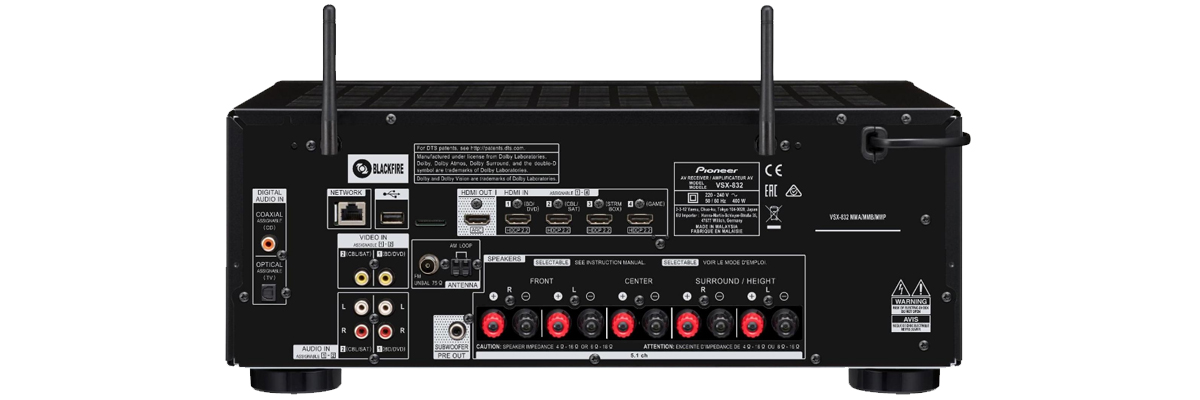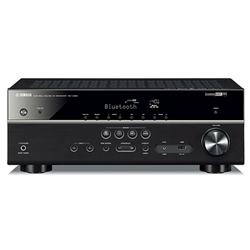 The Pioneer VSX-832 AV receiver with amplifier section on the powerful Direct-Energy output stages will turn your living room into a Dolby Atmos movie theater. Don’t miss a chance to read Pioneer VSX-832 review first and find out all the Pioneer VSX-832 specs.
The Pioneer VSX-832 AV receiver with amplifier section on the powerful Direct-Energy output stages will turn your living room into a Dolby Atmos movie theater. Don’t miss a chance to read Pioneer VSX-832 review first and find out all the Pioneer VSX-832 specs.
Pioneer VSX-832 review
Features
The latest development of the Surround Enhancer will make optional rear speakers available for full surround sound. When using speakers with Dolby Atmos support, two front speakers and one center speaker are enough to create surround sound for the new audio format. The VSX-832 is the first Pioneer AV receiver to support object-oriented 5.1 Dolby Atmos and DTS: X audio. In turn, the VSX-932 with sound support 7.2 plays audio tracks in movies according to 5.2.2. It supports power up to 130 W / channel (6 Ohms).
Design and build
Video with HDR (High Dynamic Range) 6 in HDR 10 or Dolby Vision formats is transmitted to a compatible display, as well as BT.2020 video format, which provides the picture with especially rich colors. In addition, the new receivers support the Super Resolution feature, which uses ultra-high resolution technology developed for the Pioneer BDP-LX88 flagship Blu-ray player. Super Resolution - 4K video scaling technology designed for HD content.

Connectivity
Through its four HDMI inputs, the Pioneer VSX-832 AV receiver handles the modern Ultra HD 4K video format (60p, 4: 4: 4, 24 bit) with the HDR range, which will make your home theater modern and meet the most modern standards over the years. You do not even need to connect a signal source to listen to music. Because the Pioneer VSX-832 itself is a source of software thanks to Spotify, Tidal, and Deezer's built-in streaming services.
Setup
The MCACC (Multi-Channel Acoustic Calibration System), developed with the assistance of professional recording studios, creates the perfect acoustic environment. Using a special microphone, the parameters of the propagation of sound waves are measured, the location and dimensions of the speakers, their sensitivity are determined, after which the system compensates for the unevenness of the frequency response.
Pros and Cons
Pros
- Surprisingly responsive home-network streaming
- Satisfying power for both two-channel and multi-channel modes
Cons
- Five-channel power requires choice between height or rear channels
- No analog multiroom capability
Common features
Product
Model
Brand
Reviews
Amplifier
Channels
Stereo power (RMS), W/Ohm
Output impedance, Ohm
Frequency response
THD in stereo, %
Audio features
Digital to analog converter (DAC)
Bi-amping
Pure direct (straight)
Auto speaker calibration
Speaker A/B switching
Other audio features
Connectivity
Wi-Fi
USB
Bluetooth
Ethernet (RJ45)
DLNA
MHL
Streaming services
Apple Music (AirPlay)
Amazon Music
Spotify
Other streaming services
Extensive connection
HDMI input/output
HDMI ARC (Audio Return Channel)
HDMI eARC (Enhanced Audio Return Channel)
HDMI CEC
Digital content protection (HDCP)
Subwoofer output (LFE)
Headphone output
Optical digital input
Coaxial digital input
Composite input
Component input/output
Phono (MM) input
Front panel connectors
Multi channel preamp output
Video features
HDR (High Dynamic Range)
4K signal pass-through
8K signal pass-through
HDMI signal pass-through
3D signal pass-through
HDMI pass-through in standby mode
Video conversion
Analog to HDMI scaling
HDMI to HDMI scaling
Dolby Vision
Other video features
Additional features
Voice control
App control
Display
Tuner
Sleep timer
Auto power off
ECO mode
Graphical user interface (GUI)
Setup assistant
Firmware update
Other additional features
Multi-room
Multi-room zones
Zone audio output
Zone HDMI output
Multi-room control
RS-232
Remote control input/output (IR)
DC trigger output (12V)
Multichannel surround
Dolby Atmos
Dolby TrueHD
Dolby Surround
Dolby (other)
DTS:X
DTS HD Master
DTS Virtual:X
DTS Neural:X
DTS (other)
Auro-3D
IMAX Enhanced
Multichannel stereo
Audio file formats
MP3
WMA
AAC
WAV
FLAC
ALAC
Other audio file formats
Power
Operational power consumption, W
Standby consumption, W
Removable power cord
User manual
Manual
Dimensions
Size W x H x D, cm/inches
Weight, kg/lbs
Other
Release year



